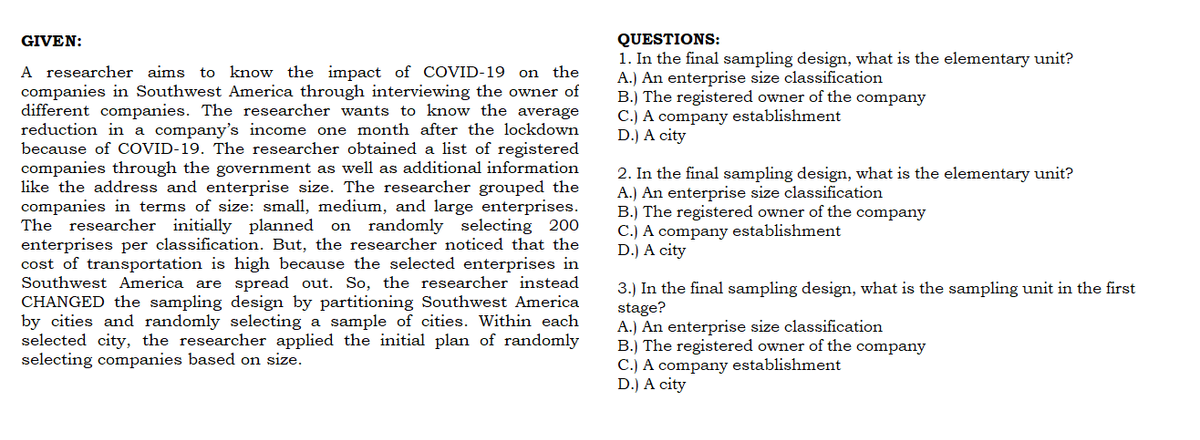GIVEN: A researcher aims to know the impact of COVID-19 on the companies in Southwest America through interviewing the owner of different companies. The researcher wants to know the average reduction in a company's income one month after the lockdown because of COVID-19. The researcher obtained a list of registered companies through the government as well as additional information like the address and enterprise size. The researcher grouped the companies in terms of size: small, medium, and large enterprises. The researcher initially planned on randomly selecting 200 enterprises per classification. But, the researcher noticed that the cost of transportation is high because the selected enterprises in Southwest America are spread out. So, the researcher instead CHANGED the sampling design by partitioning Southwest America by cities and randomly selecting a sample of cities. Within each selected city, the researcher applied the initial plan of randomly selecting companies based on size. QUESTIONS: 1. In the final sampling design, what is the elementary unit? A.) An enterprise size classification B.) The registered owner of the company C.) A company establishment D.) A city 2. In the final sampling design, what is the elementary unit? A.) An enterprise size classification B.) The registered owner of the company C.) A company establishment D.) A city 3.) In the final sampling design, what is the sampling unit in the first stage? A.) An enterprise size classification B.) The registered owner of the company C.) A company establishment D.) A city
GIVEN: A researcher aims to know the impact of COVID-19 on the companies in Southwest America through interviewing the owner of different companies. The researcher wants to know the average reduction in a company's income one month after the lockdown because of COVID-19. The researcher obtained a list of registered companies through the government as well as additional information like the address and enterprise size. The researcher grouped the companies in terms of size: small, medium, and large enterprises. The researcher initially planned on randomly selecting 200 enterprises per classification. But, the researcher noticed that the cost of transportation is high because the selected enterprises in Southwest America are spread out. So, the researcher instead CHANGED the sampling design by partitioning Southwest America by cities and randomly selecting a sample of cities. Within each selected city, the researcher applied the initial plan of randomly selecting companies based on size. QUESTIONS: 1. In the final sampling design, what is the elementary unit? A.) An enterprise size classification B.) The registered owner of the company C.) A company establishment D.) A city 2. In the final sampling design, what is the elementary unit? A.) An enterprise size classification B.) The registered owner of the company C.) A company establishment D.) A city 3.) In the final sampling design, what is the sampling unit in the first stage? A.) An enterprise size classification B.) The registered owner of the company C.) A company establishment D.) A city
MATLAB: An Introduction with Applications
6th Edition
ISBN:9781119256830
Author:Amos Gilat
Publisher:Amos Gilat
Chapter1: Starting With Matlab
Section: Chapter Questions
Problem 1P
Related questions
Question

Transcribed Image Text:GIVEN:
A researcher aims to know the impact of COVID-19 on the
companies in Southwest America through interviewing the owner of
different companies. The researcher wants to know the average
reduction in a company's income one month after the lockdown
because of COVID-19. The researcher obtained a list of registered
companies through the government as well as additional information
like the address and enterprise size. The researcher grouped the
companies in terms of size: small, medium, and large enterprises.
The researcher initially planned on randomly selecting 200
enterprises per classification. But, the researcher noticed that the
cost of transportation is high because the selected enterprises in
Southwest America are spread out. So, the researcher instead
CHANGED the sampling design by partitioning Southwest America
by cities and randomly selecting a sample of cities. Within each
selected city, the researcher applied the initial plan of randomly
selecting companies based on size.
QUESTIONS:
1. In the final sampling design, what is the elementary unit?
A.) An enterprise size classification
B.) The registered owner of the company
C.) A company establishment
D.) A city
2. In the final sampling design, what is the elementary unit?
A.) An enterprise size classification
B.) The registered owner of the company
C.) A company establishment
D.) A city
3.) In the final sampling design, what is the sampling unit in the first
stage?
A.) An enterprise size classification
B.) The registered owner of the company
C.) A company establishment
D.) A city
Expert Solution
This question has been solved!
Explore an expertly crafted, step-by-step solution for a thorough understanding of key concepts.
Step by step
Solved in 2 steps

Recommended textbooks for you

MATLAB: An Introduction with Applications
Statistics
ISBN:
9781119256830
Author:
Amos Gilat
Publisher:
John Wiley & Sons Inc

Probability and Statistics for Engineering and th…
Statistics
ISBN:
9781305251809
Author:
Jay L. Devore
Publisher:
Cengage Learning

Statistics for The Behavioral Sciences (MindTap C…
Statistics
ISBN:
9781305504912
Author:
Frederick J Gravetter, Larry B. Wallnau
Publisher:
Cengage Learning

MATLAB: An Introduction with Applications
Statistics
ISBN:
9781119256830
Author:
Amos Gilat
Publisher:
John Wiley & Sons Inc

Probability and Statistics for Engineering and th…
Statistics
ISBN:
9781305251809
Author:
Jay L. Devore
Publisher:
Cengage Learning

Statistics for The Behavioral Sciences (MindTap C…
Statistics
ISBN:
9781305504912
Author:
Frederick J Gravetter, Larry B. Wallnau
Publisher:
Cengage Learning

Elementary Statistics: Picturing the World (7th E…
Statistics
ISBN:
9780134683416
Author:
Ron Larson, Betsy Farber
Publisher:
PEARSON

The Basic Practice of Statistics
Statistics
ISBN:
9781319042578
Author:
David S. Moore, William I. Notz, Michael A. Fligner
Publisher:
W. H. Freeman

Introduction to the Practice of Statistics
Statistics
ISBN:
9781319013387
Author:
David S. Moore, George P. McCabe, Bruce A. Craig
Publisher:
W. H. Freeman